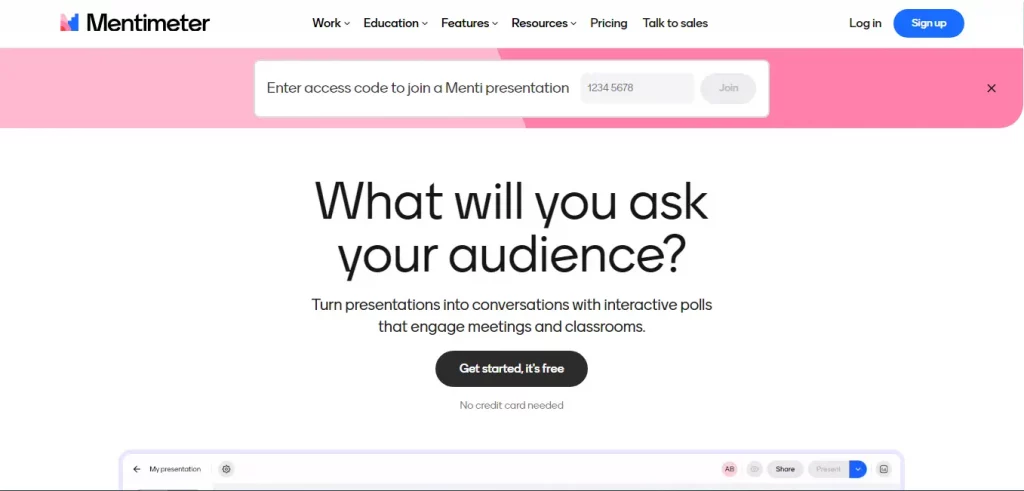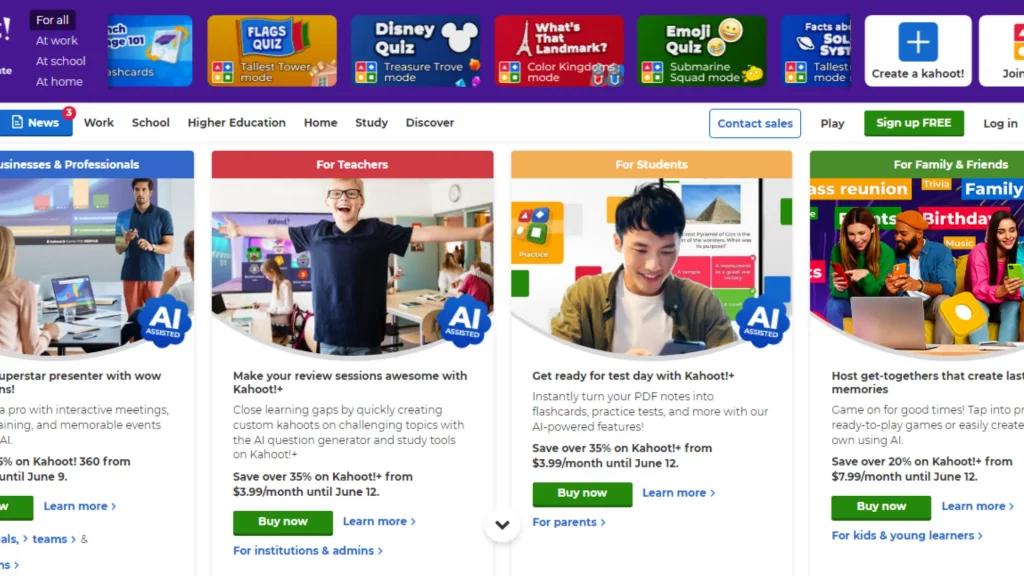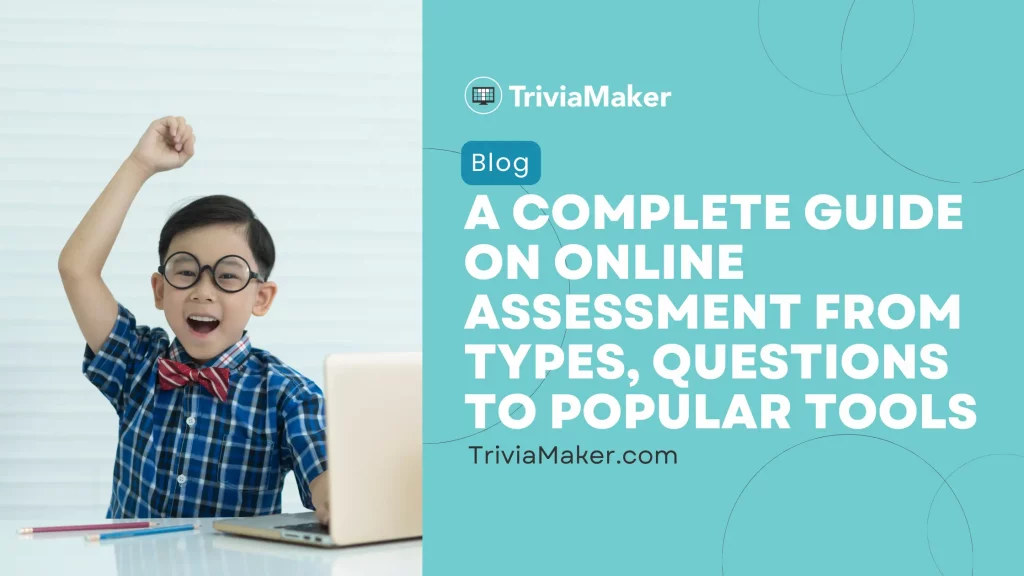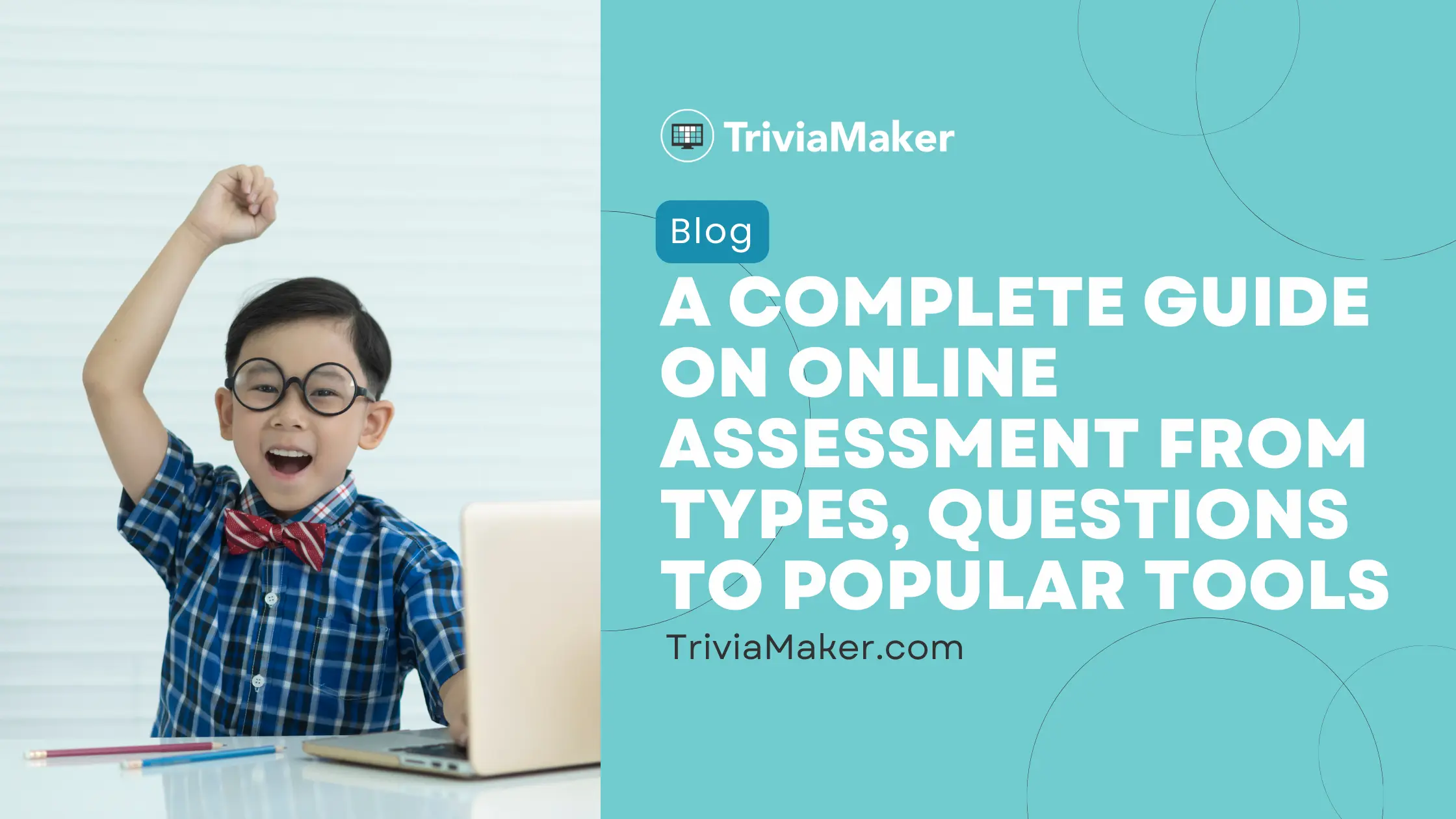The world of education is changing fast. Technology is leading this change. One big shift is from paper-based tests to online evaluations. Online assessment is a key in modern education. They offer a dynamic and efficient way to measure student learning.
In this guide, we will explore online assessments. We’ll explain what they are, their benefits, and their challenges. We’ll also compare them to traditional assessments. Plus, we will review five popular online assessment software to help you find the best one for your needs.
Are you a teacher, who wants better assessment methods? Are you a student, curious about online tests? Or are you an administrator looking to improve your school’s strategies? This guide is for you. Let’s discover how online assessments can transform education.
What is Online Assessment?
Online assessment is a modern way to measure how much students have learned. Students no longer use paper tests. They take exams or quizzes on computers, tablets, or smartphones. This digital shift has changed how teachers evaluate student knowledge and skills.
Imagine a classroom where students get instant feedback on their work. Teachers can quickly see how well the class understands a topic. That’s the power of online assessment. It’s not just about making things easier. It’s about making learning better and more fun.
Suggested Read:
Types of Online Assessment Tests
Online assessment test can be of different types. Each type measures certain skills and knowledge. Let’s explore the main types:
Objective Tests
These tests focus on facts and specific answers.
- Multiple-choice questions: Choose the correct answer from several options.
- True or false questions: Decide if a statement is true or false.
- Matching questions: Pair items from two lists.
- Fill-in-the-blank questions: Complete a sentence with the right word.
Subjective Tests
These tests let students show their understanding in their own words.
- Essay questions: Write a detailed answer to a question.
- Short answer questions: Provide a brief answer.
- Extended response questions: Explain your thinking and reasoning.
Performance-Based Assessments
These tests measure how well students can apply their knowledge in real-world situations.
- Projects: Complete a task or create something.
- Portfolios: Collect and showcase your work.
- Presentations: Share your ideas with an audience.
- Simulations: Practice real-life scenarios.
Adaptive Tests
These tests change based on how well you answer questions.
- Computer-adaptive tests: The difficulty of questions adjusts to your performance.
Other Types
- Online quizzes: Short, informal tests to check understanding.
- Proctored exams: Online tests with live supervision.
Suggested Read:
Top 10 Benefits of Online Assessment
Online assessments have become a popular choice in education and training. They offer several advantages that can enhance learning and streamline evaluation processes. Here are the top 10 benefits:
1. Accessibility:
- Online assessments can be taken from anywhere with an internet connection. This lets students and employees finish their tests without being in one place.
2. Flexibility:
- Users can often choose when to take their assessments. This flexibility lets people take tests when it fits their schedule. This makes it more convenient and less stressful.
3. Instant Feedback:
- Many online assessments provide immediate results. This quick feedback helps learners understand their mistakes and improve faster.
4. Cost-Effective:
- Online assessments reduce the need for physical materials and administrative costs. There are no printing or postage costs, making it a more economical option.
5. Scalability:
- Online assessments can easily handle large numbers of participants. This scalability is ideal for organizations and educational institutions with many users.
6. Enhanced Security:
- Online assessments have security features. They may shuffle questions and set time limits. These measures help prevent cheating and ensure fair testing.
7. Data Analysis:
- Automated grading and data collection make it easier to analyze results. Detailed reports and analytics show performance trends. They also highlight areas that need improvement.
8. Environmentally Friendly:
- Reducing paper use helps protect the environment. Online assessments contribute to sustainability by eliminating the need for printed test materials.
9. Customizable:
- Online assessments can be tailored to fit specific needs. Custom questions and formats can be used. You can also adjust scoring methods. This helps match different learning goals and needs.
10. Improved Engagement:
- Interactive features like multimedia elements can make assessments more engaging. This can increase motivation and interest among participants.
Types of Questions Asked During Assessments
Assessments are crucial tools in education. They help measure students’ understanding and skills. Different types of questions are used to assess various aspects of learning. Here’s a detailed look at the types of questions commonly asked during assessments.
1. Multiple Choice Questions (MCQs)
What They Are: MCQs provide a question followed by several answer options. Only one is correct.
Why They’re Used:
- Efficiency: Quick to answer and easy to score.
- Variety: Can cover a wide range of topics in a short time.
- Objective: Reduces the chance of bias in grading.
Example: Which of the following is the capital of France? a) Berlin b) Madrid c) Paris d) Rome
2. True or False Questions
What They Are: These questions ask students to determine if a statement is correct or incorrect.
Why They’re Used:
- Simplicity: Easy to create and answer.
- Quick Assessment: Useful for testing basic knowledge or understanding of facts.
Example: The Earth revolves around the Sun. (True/False)
3. Short Answer Questions
What They Are: Students provide a brief answer to a question, usually one or two sentences long.
Why They’re Used:
- Specificity: Allows students to show their understanding in their own words.
- Flexibility: Can assess various levels of understanding and recall.
Example: What is the chemical symbol for water?
4. Essay Questions
What They Are: Students write longer responses, typically a few paragraphs, to demonstrate in-depth understanding and critical thinking.
Why They’re Used:
- Depth: Assesses students’ ability to organize and express their thoughts.
- Application: Useful for evaluating comprehension and analytical skills.
Example: Discuss the impact of climate change on coastal cities.
5. Fill-in-the-Blank Questions
What They Are: Students fill in missing words or phrases in a sentence.
Why They’re Used:
- Recall: Tests students’ ability to remember specific information.
- Clarity: Helps pinpoint exactly where a student might need more help.
Example: The process by which plants make their food is called __________.
6. Matching Questions
What They Are: Students match items from two lists, such as terms and definitions.
Why They’re Used:
- Comparison: Helps students understand relationships between concepts.
- Variety: Good for testing knowledge of pairs or categories.
Example: Match the following countries with their capitals:
- France: _____
- Japan: _____
- Brazil: _____
7. Diagram Labeling
What They Are: Students label parts of a diagram or chart.
Why They’re Used:
- Visual Understanding: Assesses students’ ability to identify and understand visual representations.
- Precision: Tests knowledge of specific details.
Example: Label the parts of the human digestive system in the diagram provided.
8. Problem-Solving Questions
What They Are: Students solve a problem using given information and show their work.
Why They’re Used:
- Application: Tests students’ ability to apply knowledge to solve practical problems.
- Process: Allows teachers to see the problem-solving process.
Example: If a train travels 60 miles in 1 hour, how far will it travel in 4 hours? Show your calculations.
9. Oral Questions
What They Are: Students answer questions verbally during a test or class discussion.
Why They’re Used:
- Communication: Assesses students’ verbal skills and spontaneous thinking.
- Immediate Feedback: Teachers can measure understanding instantly.
Example: Explain the significance of the Treaty of Versailles in world history.
How does online assessment help students?
Online assessments have become a popular way to measure student learning. They offer many benefits that can help students succeed. Let’s explore how:
Personalized Learning
- Tailored Feedback: Online assessments give instant feedback. This helps students see their mistakes and learn from them quickly.
- Identifying Strengths and Weaknesses: These assessments show where students do well. They also reveal areas where students need help.
- Customized Learning Paths: Students get recommendations based on their assessment results. These suggestions help them with further learning.
Improved Learning Outcomes
- Increased Engagement: Interactive elements and multimedia can make learning more fun and engaging.
- Better Time Management: Students can practice time management skills by taking timed assessments.
- Improved Test-Taking Skills: Online assessments help students get used to test formats. They also reduce test anxiety.
Deeper Understanding
- Focus on Critical Thinking: Many online tests help students think critically. They also encourage problem-solving.
- Real-World Application: Some assessments simulate real-world situations, helping students apply knowledge practically.
- Self-Assessment: Students can track their progress. They can see how their knowledge grows.
Flexibility and Convenience
- Access Anytime, Anywhere: Students can take assessments at their own pace and convenience.
- Multiple Attempts: Some online tests let students retake them. This helps improve their scores.
- Reduced Test Anxiety: The flexibility of online assessments can help reduce test-related stress.
List of the Best Online Assessment Software
Are you tired of spending countless hours grading papers? Looking for innovative ways to measure student progress? Look no further! This list includes top online assessment tools and software. They are designed to make your work easier and improve student learning.
These platforms have many features to match your teaching style. You can create fun quizzes and look at student data. Whether you’ve been teaching for years or are just starting, you’ll find a tool that shows how well your students are learning.
Explore the future of assessment. Help your students reach their full potential!
TriviaMaker
TriviaMaker is more than an online quiz creator. It’s a dynamic platform that changes how you assess student learning. Its game-show-style format makes learning fun and interactive. Plus, it gives you valuable insights into student performance. Trivia Maker also has an AI quiz creator tool to help you make work more easier and comfortable. It also has the Corporate Quiz Maker ability to make employees more productive.

Main Features
- Multiple choice, Single answer, and more.
- Pick a game show style. You can choose from Grid, Wheel, or List.
- Tailor quizzes to fit any subject or grade level.
- Instant results and performance data.
- Monitor student improvement over time.
- Work with other teachers or create team-based assessments.
- Easily embed quizzes into learning management systems.
- Access and play quizzes on any device.
- Points, rewards, and leaderboards to motivate students.
- Features to support students with disabilities.
What You May Love
- Students love the game-show format.
- Auto-grading and automated reporting.
- Suitable for a wide range of subjects and assessment purposes.
- Detailed performance analytics to inform instruction.
- Affordable pricing plans.
- Intuitive interface for both teachers and students.
- Create quiz games tailored to specific learning objectives.
- Promote teamwork and peer learning.
- Use for formative or summative assessment.
- Makes learning enjoyable for students.
What You May Not Love
- May not be suitable for all types of assessments.
- The game-show format might be distracting for some students.
Cost
- TriviaMaker offers a variety of pricing plans to suit different needs and budgets. They offer a free plan with limited features. They also have paid plans with more options.
Mentimeter
Mentimeter is easy to use. It turns regular quizzes into fun, interactive experiences. It’s great for getting instant feedback and checking what students understand.

Main Features
- Multiple choice, word clouds, open-ended questions, and more.
- Instant feedback on student responses.
- Polls, quizzes, and word clouds to spark discussion.
- Create visually appealing presentations.
- Works seamlessly with other tools like Google Slides.
What You May Love
- Interactive elements keep students interested.
- Real-time data helps teachers adjust lessons.
- Suitable for various subjects and age groups.
- Simple interface for both teachers and students.
- Offers free plans with limited features.
What You May Not Love
- Compared to other tools, options might be fewer.
- Requires a stable internet connection.
Cost
- Mentimeter offers a free plan with basic features. For advanced features and larger audiences, there are paid plans with varying costs. Mentimeter is a useful tool for teachers. It makes assessments more interactive and engaging.
Kahoot!
Kahoot! is a popular platform that transforms learning into a game. It’s perfect for creating engaging and interactive quizzes.

Main Features
- Turns assessments into fun competitions.
- Classic format for quick assessments.
- Instant results and leaderboards.
- Create quizzes tailored to your needs.
- Play on any device.
What You May Love
- Students love the game-show format.
- Quick assessments to check understanding.
- Motivates students to learn.
- Simple interface for both teachers and students.
- Accessible to all educators.
What You May Not Love
- Mainly multiple choice.
- Requires a stable connection.
Cost
- Kahoot! offers a free plan with basic features. For additional features and larger audiences, there are paid plans available. Kahoot! is a fantastic tool for making assessments fun and effective
Socrative
Socrative is easy to use. It helps you see how well students understand the material. It gives instant feedback and fun activities.

Main Features
- Create and deliver instant polls or questions.
- Build comprehensive assessments with various question types.
- Turn quizzes into a fun, competitive game.
- Collect and analyze student data.
- Works with other educational tools.
What You May Love
- Instant insights into student learning.
- Space Race and other games make learning fun.
- Suitable for formative and summative assessments.
- Simple interface for teachers and students.
- Provides valuable performance data.
What You May Not Love
- Focuses mainly on multiple choice and short answer.
- Data analysis features might be limited compared to other tools.
Cost
- Socrative offers a free plan with basic features. For additional features and larger classrooms, there are paid plans available. Socrative helps teachers check if students understand lessons. It also helps with making decisions based on data.
Quizlet
Quizlet is more than flashcards. It’s a full learning platform. Its interactive features make it a great tool for assessments.

Main Features
- Create digital flashcards for quick review.
- Various study modes like match, learn, test, and spell.
- Generate practice tests from flashcards.
- Play interactive games with classmates.
- Study and play on the go.
What You May Love
- Students can create and share study sets.
- Game-like features make learning fun.
- Multiple ways to study and assess.
- Accessible to all students and teachers.
- Create personalized study sets.
What You May Not Love
- Mainly focused on flashcards and vocabulary.
- Students might rely too heavily on memorization.
Cost
- Quizlet offers a free basic plan with premium features available for a fee. Quizlet helps both students and teachers. It offers a flexible platform for learning and assessment.
How to Choose the Right Online Assessment Tool
Selecting the perfect online assessment platform can be overwhelming. There are many options. Think about what you need and what’s most important to you. Here’s a guide to help you make an informed decision:
Define Your Needs
- Identify your goals: What do you want to achieve with online assessments? Improve student engagement, measure knowledge, or streamline grading?
- Consider your audience: Who will be using the tool? Students, teachers, or administrators?
- Determine your budget: Set a realistic budget for the tool and its features.
Essential Features to Look For
- Question types: Ensure the tool supports the types of questions you need (multiple choice, essay, short answer, etc.).
- Assessment creation: Check if the tool allows easy creation and customization of assessments.
- Auto-grading: Look for tools that can automatically grade multiple-choice and fill-in-the-blank questions.
- Feedback options: Evaluate how well the tool provides feedback to students and teachers.
- Data analysis: Consider tools that offer insights into student performance and progress.
- Integration: Check if the tool integrates with your learning management system (LMS).
- Security: Prioritize tools that offer robust security features to protect student data.
Test and Compare
- Free trials: Many tools offer free trials. You can try their features for yourself.
- Demo requests: Schedule demos with the tools you like. Ask questions and watch how they work.
- User reviews: Read reviews from other educators to get insights into their experiences.
Best Practices for Using Online Assessments
Online assessments offer numerous benefits, but using them effectively requires careful planning. Here are some best practices:
Align Assessments with Learning Objectives
- Clear goals: Make sure assessments test what students should know or be able to do.
- Variety of question types: Use different question formats to assess various learning levels.
Create Engaging Assessments
- Interactive elements: Incorporate multimedia and interactive features to keep students interested.
- Real-world scenarios: Make assessments relevant to students’ lives.
- Time management: Set appropriate time limits for each question or section.
Provide Clear Instructions
- Detailed guidelines: Offer clear instructions on how to complete the assessment.
- Examples: Provide examples of correct and incorrect answers.
- Technical support: Offer assistance for students experiencing technical difficulties.
Use a Variety of Assessment Types
- Formative and summative: Combine both types to monitor progress and evaluate overall learning.
- Objective and subjective: Use a mix of multiple-choice, essay, and performance-based assessments.
Ensure Accessibility
- Alternative formats: Provide accommodations for students with disabilities.
- Clear font and layout: Make assessments easy to read.
Analyze Assessment Data
- Identify strengths and weaknesses: Use data to inform instruction and provide targeted feedback.
- Track student progress: Monitor student growth over time.
Maintain Assessment Integrity
- Prevent cheating: Use tools like question randomization and time limits.
- Proctoring: Consider using proctoring services for high-stakes assessments.
Final Thoughts
online assessment tools for teachers are changing education. They are quick and flexible. They provide instant feedback and increase engagement. They also match different learning styles. Teachers can support students better with online tests.
Teachers, students, and administrators can improve learning with the right online tools. These tools also help track progress. Using them can make learning more dynamic and effective.


